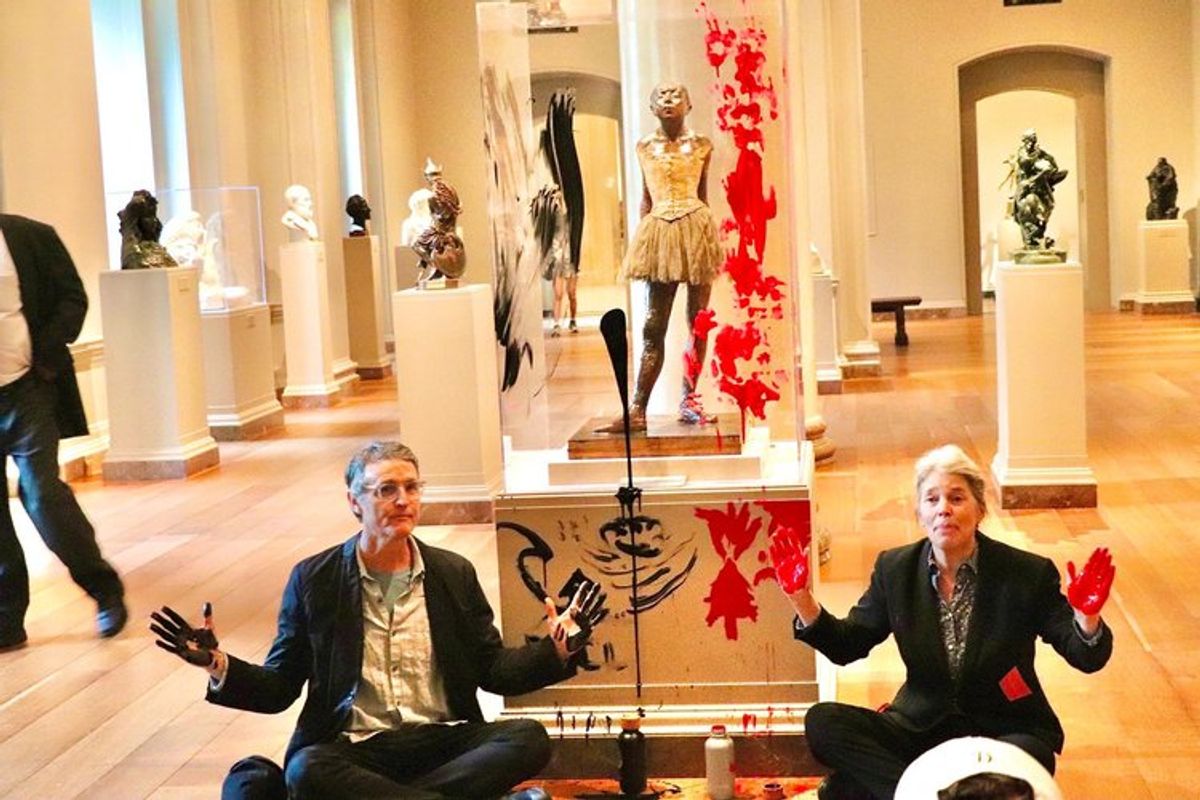Climate protesters have vandalised the display case of Edgar Degas’ Little Dancer sculpture at the National Gallery of Art museum in Washington, D.C.
Two protesters, who have not yet been named and did not pledge allegiance to a protest group, smeared red and black paint on the display case of the small wax sculpture titled La Petite Danseuse de quatorze ans or Little Dancer Aged Fourteen, which was created by the French impressionist artist in 1880.
Kaywin Feldman, the director of the museum, “unequivocally denounced this physical attack,” she said in a statement. She called Little Dancer “a priceless work of art”. The sculpture was taken off display while museum conservators “assess potential damage,” Feldman said.
On Twitter, video footage posted by the Washington Post shows a man and a woman dressed in black suits daubing the case with paint before then staging a sit-in protest in front of the vandalised case before being handcuffed and forcibly detained by security. One of the protestors can be heard requesting the US government “help protect the health and safety of our children”. The Federal Bureau of Investigation is assisting in the investigation, Feldman said.
The artwork is the only sculpture Degas exhibited publicly during his lifetime, when it went on show in Paris in 1881. It is based on a young ballerina named Marie van Goethem, who was studying ballet in Paris.
The National Gallery of Art has long displayed the original sculpture, but several bronze casts have been made. One of the casts sold for $41.6m after being auctioned from the from the collection of the late Anne Bass, the former wife of the Texan oil billionaire Sid Bass. The cast was sold at a Christie’s sale in May 2022.
The attack echoes the protests of groups like Just Stop Oil in the UK, who made headlines on 14 October 2022 when activists threw tomato soup at Vincent van Gogh’s Sunflowers at London’s National Gallery. Ten days later, protestors from the Letzte Generation(Last Generation) group mirrored the attack by smearing mashed potatoes on the Claude Monet painting Les Meules on display at the Museum Barberini in Potsdam, Germany. A man also attacked Leonardo da Vinci’s Mona Lisa with cake at the Louvre, Paris in May 2022.
The use of foodstuffs to vandalise artwork marked an escalation on earlier protests in which protestors glued themselves to the frames of famous paintings, including, most notably, John Constable’s The Hay Wain.
In Germany, protesters have stuck themselves to works including Rubens’s Massacre of the Innocents at the Alte Pinakothek museum in Munich, while in Italy, works in the Uffizi museum in Florence and at the Vatican Museums in Rome have also been targeted.
In November 2022, Just Stop Oil activists warned they would be willing to “escalate” their protests by slashing or destroying paintings in order to communicate their message on climate change. The use of paint on Little Dancer will be considered such an escalation.
The International Council of Museums (ICOM) has stated its opposition to all climate activism protests that vandalise art, saying protestors “severely underestimate the fragility” of works on show. ICOM said museums should be "key actors in initiating and supporting climate action".
In 1914, the feminist activist Mary Richardson attacked the Diego Velazquez painting The Rokeby Venus with a meat cleaver, causing extensive damage, in a protest against the arrest of her fellow suffragette Emmeline Pankhurst.


